The Use of TOPSIS Method for Multi-Objective Optimization in Milling Ti-MMC
Abstract
1. Introduction
1.1. Background
- Full aggregation methods, such as the analytic hierarchy process (AHP). This method assigns a weight to each criterion to show its importance. Then, the value of each alternative is determined and the highest positive value shows the best fit. The drawback is the complexity and time-consuming process depending on the inputs’ numbers.
- Outranking methods, such as the ELimination Et Choix Traduisant la REalité (ELECTRE). In this method, to rank the alternatives, each pair of alternatives is compared for each criterion. The drawback is that this method needs several technical parameters, which are sometimes complex and hard to understand.
- Goal, aspiration, or reference level methods, such as the TOPSIS method. The most significant advantage of this method is that it needs only a few inputs and its output is easy to understand. This makes the process pretty straightforward and comprehensible. This is the main reason for using TOPSIS for this study.
1.2. Contribution of This Work
2. Materials and Methods
Machining Tests
3. Results
3.1. Cutting Conditions and Experimental Results
3.2. Conversion of Multiple Responses into a Single Response Using the TOPSIS Method
3.3. Determination of Optimum Cutting Parameters Using the Taguchi Approach
4. Discussion
Probability Plots
5. Conclusions
Author Contributions
Funding
Data Availability Statement
Conflicts of Interest
References
- Garg, G.K.; Garg, S.; Sangwan, K. Development of an empirical model for optimization of machining parameters to minimize power consumption. In IOP Conference Series: Materials Science and Engineering; IOP Publishing: Bristol, UK, 2018. [Google Scholar]
- Kant, G.; Sangwan, K.S. Predictive Modelling and Optimization of Machining Parameters to Minimize Surface Roughness using Artificial Neural Network Coupled with Genetic Algorithm. Procedia CIRP 2015, 31, 453–458. [Google Scholar] [CrossRef]
- Kant, G.; Sangwan, K.S. Predictive Modeling for Power Consumption in Machining Using Artificial Intelligence Techniques. Procedia CIRP 2015, 26, 403–407. [Google Scholar] [CrossRef]
- Pusavec, F. Sustainable machining of high temperature Nickel alloy–Inconel 718: part 2–chip breakability and optimization. J. Clean. Prod. 2015, 87, 941–952. [Google Scholar] [CrossRef]
- Bagaber, S.A.; Yusoff, A.R. Multi-objective optimization of cutting parameters to minimize power consumption in dry turning of stainless steel 316. J. Clean. Prod. 2017, 157, 30–46. [Google Scholar] [CrossRef]
- Bilga, P.S.; Singh, S.; Kumar, R. Optimization of energy consumption response parameters for turning operation using Taguchi method. J. Clean. Prod. 2016, 137, 1406–1417. [Google Scholar] [CrossRef]
- Kumar, R.; Bilga, P.S.; Singh, S. Multi objective optimization using different methods of assigning weights to energy consumption responses, surface roughness and material removal rate during rough turning operation. J. Clean. Prod. 2017, 164, 45–57. [Google Scholar] [CrossRef]
- Hwang, C.-L.; Yoon, K. Methods for multiple attribute decision making. In Multiple Attribute Decision Making; Springer: Berlin/Heidelberg, Germany, 1981; pp. 58–191. [Google Scholar]
- Wu, Z.; Abdul-Nour, G. Comparison of multi-criteria group decision-making methods for urban sewer network plan selection. CivilEng 2020, 1, 3. [Google Scholar] [CrossRef]
- Rao, S.R.; Jeelani, S.A.K.; Swamulu, V. Multi-objective optimization using TOPSIS in turning of Al 6351 alloy. IOP Conf. Ser. Mater. Sci. Eng. 2021, 1112, 012010. [Google Scholar] [CrossRef]
- Mandal, P.; Mondal, S.C. Multi-objective optimization of Cu-MWCNT composite electrode in electro discharge machining using MOPSO-TOPSIS. Measurement 2020, 169, 108347. [Google Scholar] [CrossRef]
- Aramesh, M. Machinability of Titanium Metal Matrix Composites (Ti-MMCs); École Polytechnique de Montréal: Montréal, QC, Canada, 2015. [Google Scholar]
- Veiga, C.; Davim, J.; Loureiro, A. Review on machinability of titanium alloys: the process perspective. Rev. Adv. Mater. Sci. 2013, 34, 148–164. [Google Scholar]
- Zhu, D.; Zhang, X.; Ding, H. Tool wear characteristics in machining of nickel-based superalloys. Int. J. Mach. Tools Manuf. 2013, 64, 60–77. [Google Scholar] [CrossRef]
- Konig, W. Applied Research on the Machinability of Titanium and its Alloys. In Proceedings of the AGARD Conference Advanced Fabrication Processes, Florence, Italy, 10 September 1978. [Google Scholar]
- Shi, B.; Attia, H.; Tounsi, N. Identification of Material Constitutive Laws for Machining—Part II: Generation of the Constitutive Data and Validation of the Constitutive Law. J. Manuf. Sci. Eng. 2010, 132, 051009. [Google Scholar] [CrossRef]
- Jin, L.; Riahi, A.R.; Edrisy, F.A. Investigation on interfacial adhesion of Ti–6Al–4V/nitride coatings. Surf. Coat. Technol. 2014, 260, 155–167. [Google Scholar] [CrossRef]
- Bejjani, R. Machinability and Modeling of Cutting Mechanism for Titanium Metal Matrix Composites; École Polytechnique de Montréal: Montréal, QC, Canada, 2012. [Google Scholar]
- Liang, L.; Xu, M.; Chen, Y.; Zhang, T.; Tong, W.; Liu, H.; Wang, H.; Li, H. Effect of welding thermal treatment on the microstructure and mechanical properties of nickel-based superalloy fabricated by selective laser melting. Mater. Sci. Eng. A 2021, 819, 141507. [Google Scholar] [CrossRef]
- Zhong, M. Mechanical properties of micro laser welding NiTiNb/Ti6Al4V dissimilar alloys lap joints with nickel interlayer. Mater. Lett. 2021, 306, 130896. [Google Scholar] [CrossRef]
- Duong, X.T. Chaos Theory Applied to Analyze Tool Wear during Machining of Titanium Metal Matrix Composite (TiMMCs); École Polytechnique de Montréal: Montréal, QC, Canada, 2015. [Google Scholar]
- Duong, X.-T.; Balazinski, M.; Mayer, R. Chaotic tool wear during machining of titanium metal matrix composite (TiMMCs). In ASME International Mechanical Engineering Congress and Exposition; American Society of Mechanical Engineers: Montréal, QC, Canada, 2014. [Google Scholar]
- Aramesh, M.; Montazeri, S.; Velduis, S. Ultra Soft Cutting Tool Coatings and Coating Method. U.S. Patent 20190314900, 17 October 2019. [Google Scholar]
- Abdelali, H.B.; Courbon, C.; Rech, J.; Salem, W.B.; Dogui, A.; Kapsa, P. Identification of a friction model at the tool-chip-workpiece interface in dry machining of a AISI 1045 steel with a TiN coated carbide tool. J. Tribol. 2011, 133, 042201. [Google Scholar] [CrossRef]
- Beste, U.; Jacobson, S. A new view of the deterioration and wear of WC/Co cemented carbide rock drill buttons. Wear 2008, 264, 1129–1141. [Google Scholar] [CrossRef]
- Kamali Zadeh, S. Initial Tool Wear Mechanisms in Turning of Titanium Metal Matrix Composites; École Polytechnique de Montréal: Montréal, QC, Canada, 2016. [Google Scholar]
- Bermingham, M.; Kirsch, J.; Sun, S.; Palanisamy, S.; Dargusch, M. New observations on tool life, cutting forces and chip morphology in cryogenic machining Ti-6Al-4V. Int. J. Mach. Tools Manuf. 2011, 51, 500–511. [Google Scholar] [CrossRef]
- Bejjani, R.; Balazinski, M.; Attia, H.; Plamondon, P.; L’Éspérance, G. Chip formation and microstructure evolution in the adiabatic shear band when machining titanium metal matrix composites. Int. J. Mach. Tools Manuf. 2016, 109, 137–146. [Google Scholar] [CrossRef]
- Duong, X.; Mayer, J.; Balazinski, M. Initial tool wear behavior during machining of titanium metal matrix composite (TiMMCs). Int. J. Refract. Met. Hard Mater. 2016, 60, 169–176. [Google Scholar] [CrossRef]
- Aramesh, M.; Attia, H.M.; Kishawy, H.A.; Balazinski, M. Observation of a unique wear morphology of cBN inserts during machining of titanium metal matrix composites (Ti-MMCs); leading to new insights into their machinability. Int. J. Adv. Manuf. Technol. 2017, 92, 519–530. [Google Scholar] [CrossRef]
- Asgari, A. Cutting Conditions Optimisation of Titanium Metal Matrix Composites in Turning and Face Milling; École Polytechnique de Montréal: Montréal, QC, Canada, 2015. [Google Scholar]
- Kamalizadeh, S.; Niknam, S.A.; Asgari, A.; Balazinski, M. Tool wear characterization in high-speed milling of titanium metal matrix composites. Int. J. Adv. Manuf. Technol. 2018, 100, 2901–2913. [Google Scholar] [CrossRef]
- Sivaiah, P.; Chakradhar, D. Performance improvement of cryogenic turning process during machining of 17-4 PH stainless steel using multi objective optimization techniques. Measurement 2018, 136, 326–336. [Google Scholar] [CrossRef]
- Krishnaraj, V.; Samsudeensadham, S.; Sindhumathi, R.; Kuppan, P. A study on High Speed End Milling of Titanium Alloy. Procedia Eng. 2014, 97, 251–257. [Google Scholar] [CrossRef]
- Montazeri, S.; Aramesh, M.; Rawal, S.; Veldhuis, S.C. Characterization and machining performance of a chipping resistant ultra-soft coating used for the machining of Inconel 718. Wear 2021, 474, 203759. [Google Scholar] [CrossRef]
- Stephens, M.A. EDF statistics for goodness of fit and some comparisons. J. Am. Stat. Assoc. 1974, 69, 730–737. [Google Scholar] [CrossRef]
- Qazi, M.I.; Akhtar, R.; Abas, M.; Khalid, Q.S.; Babar, A.R.; Pruncu, C.I. An Integrated Approach of GRA Coupled with Principal Component Analysis for Multi-Optimization of Shielded Metal Arc Welding (SMAW) Process. Materials 2020, 13, 3457. [Google Scholar] [CrossRef]
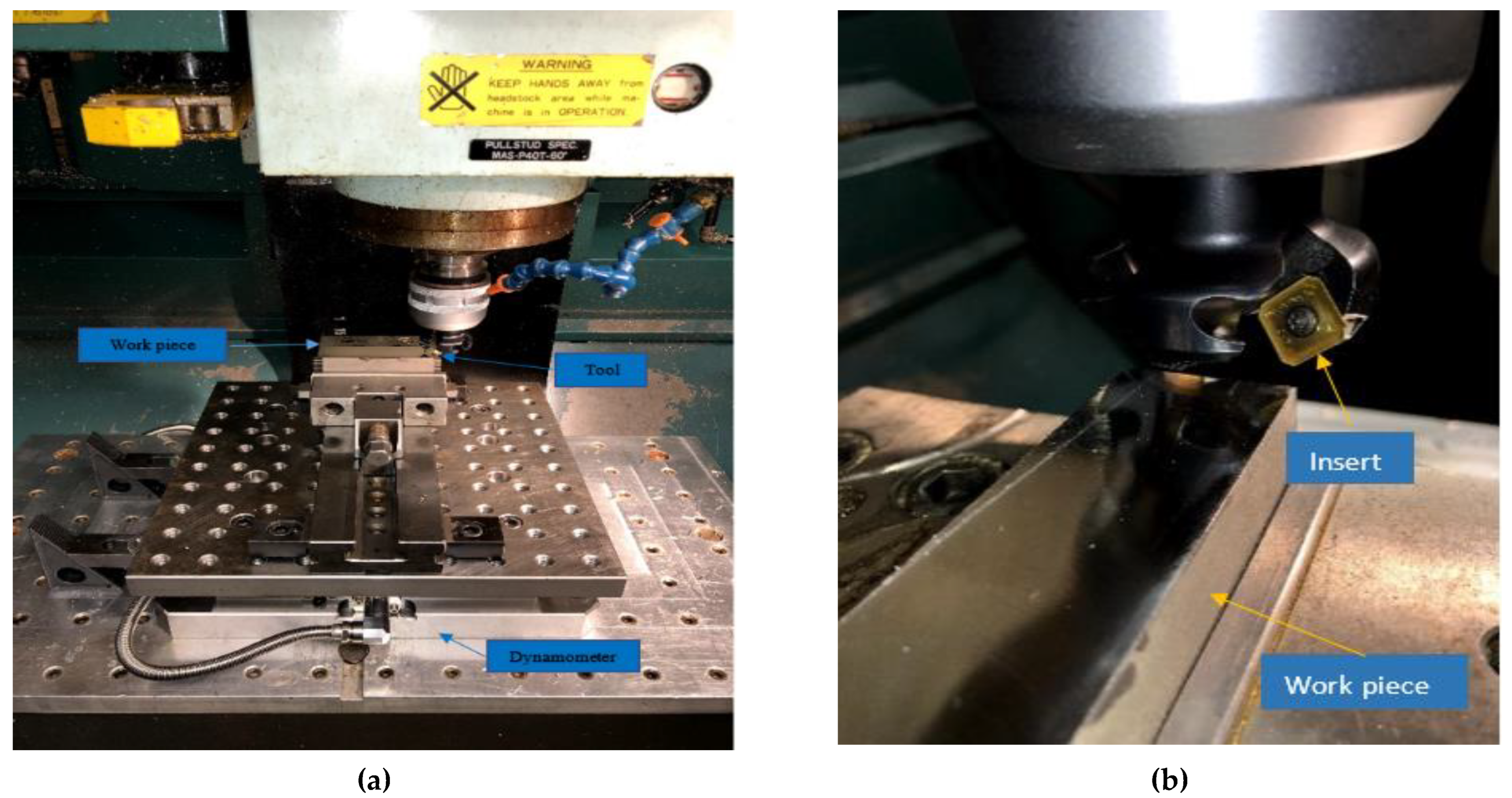
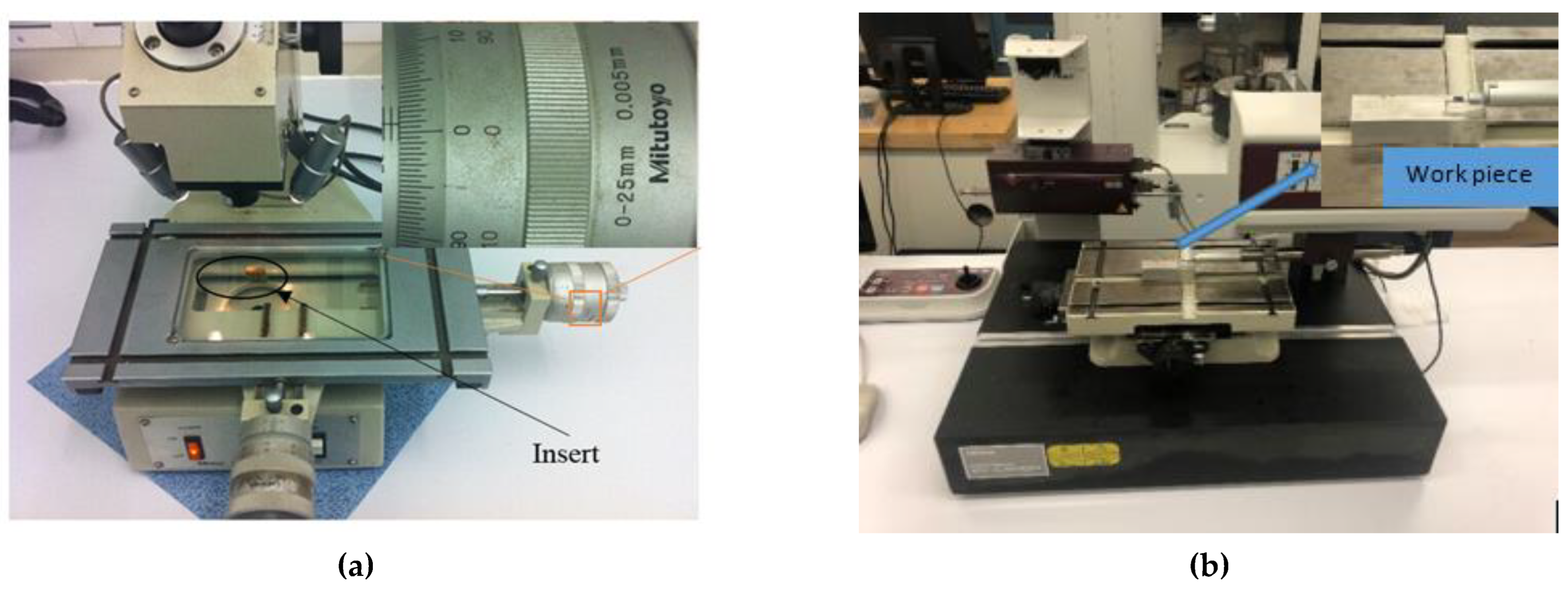
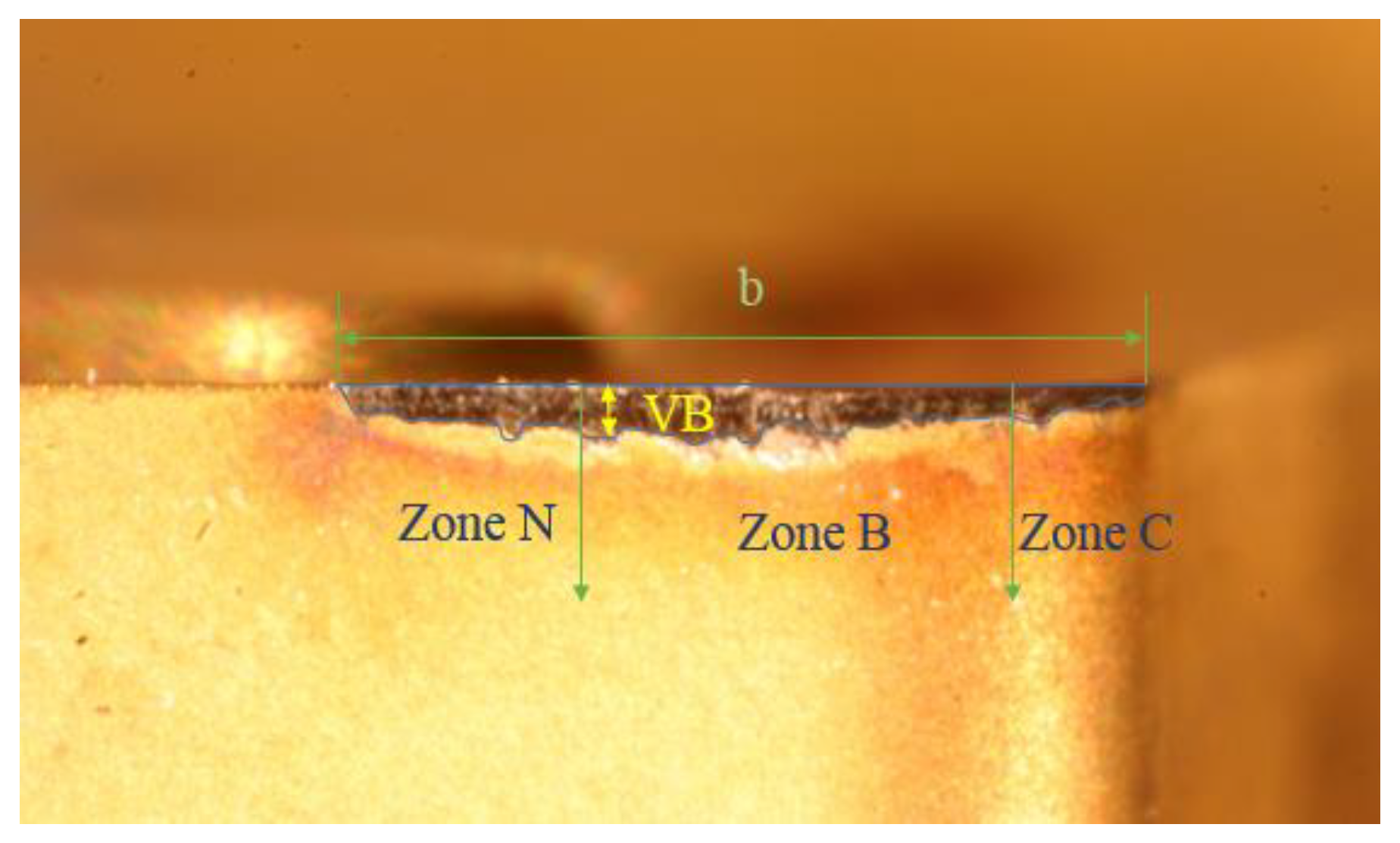

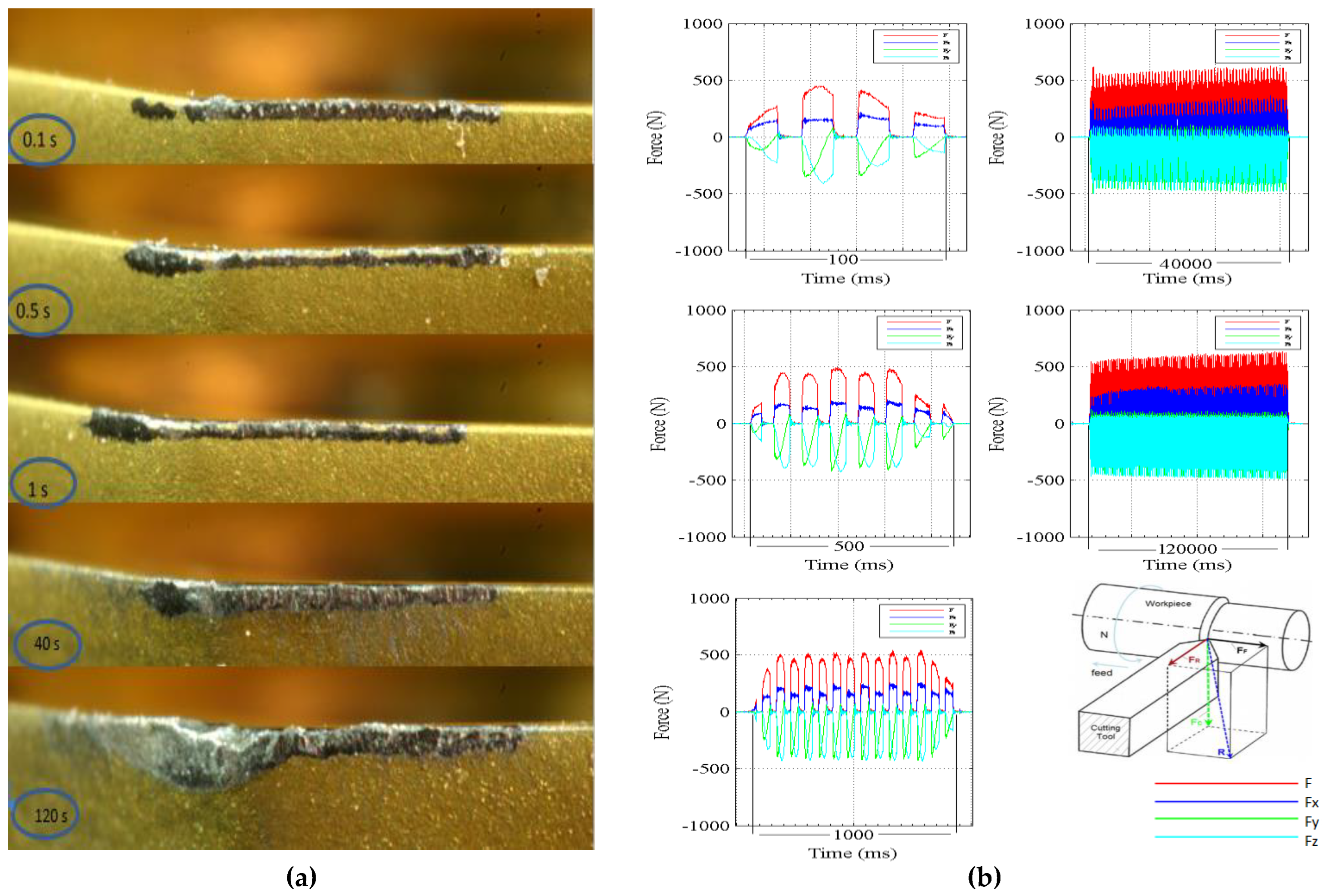
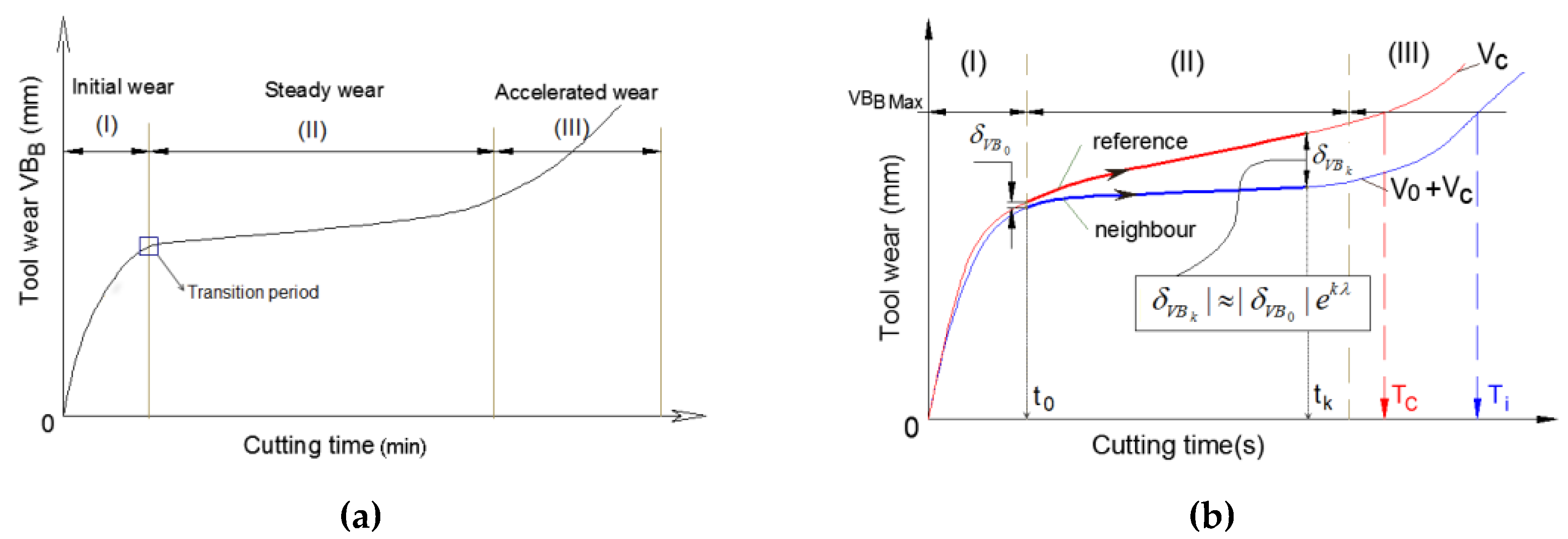
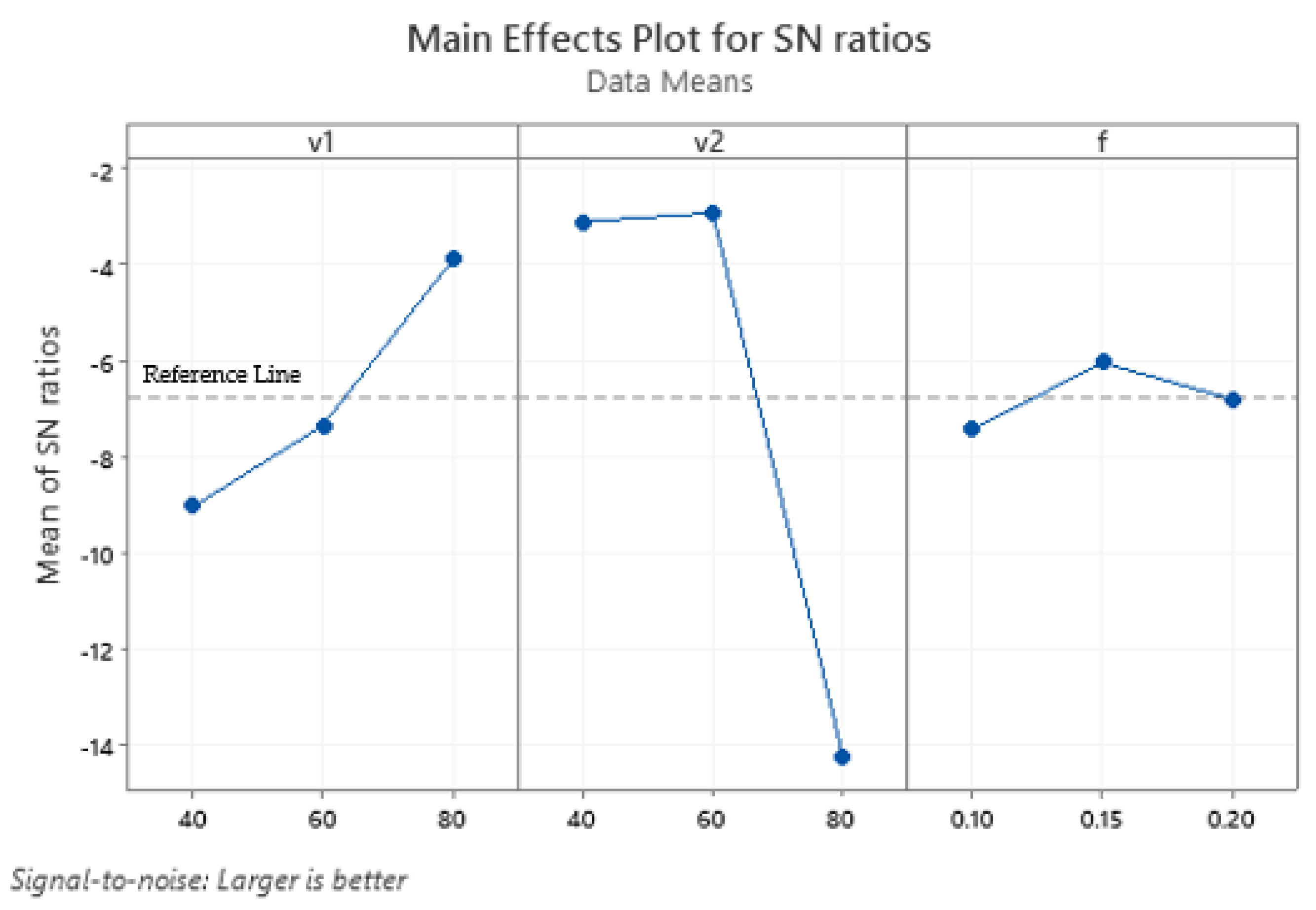
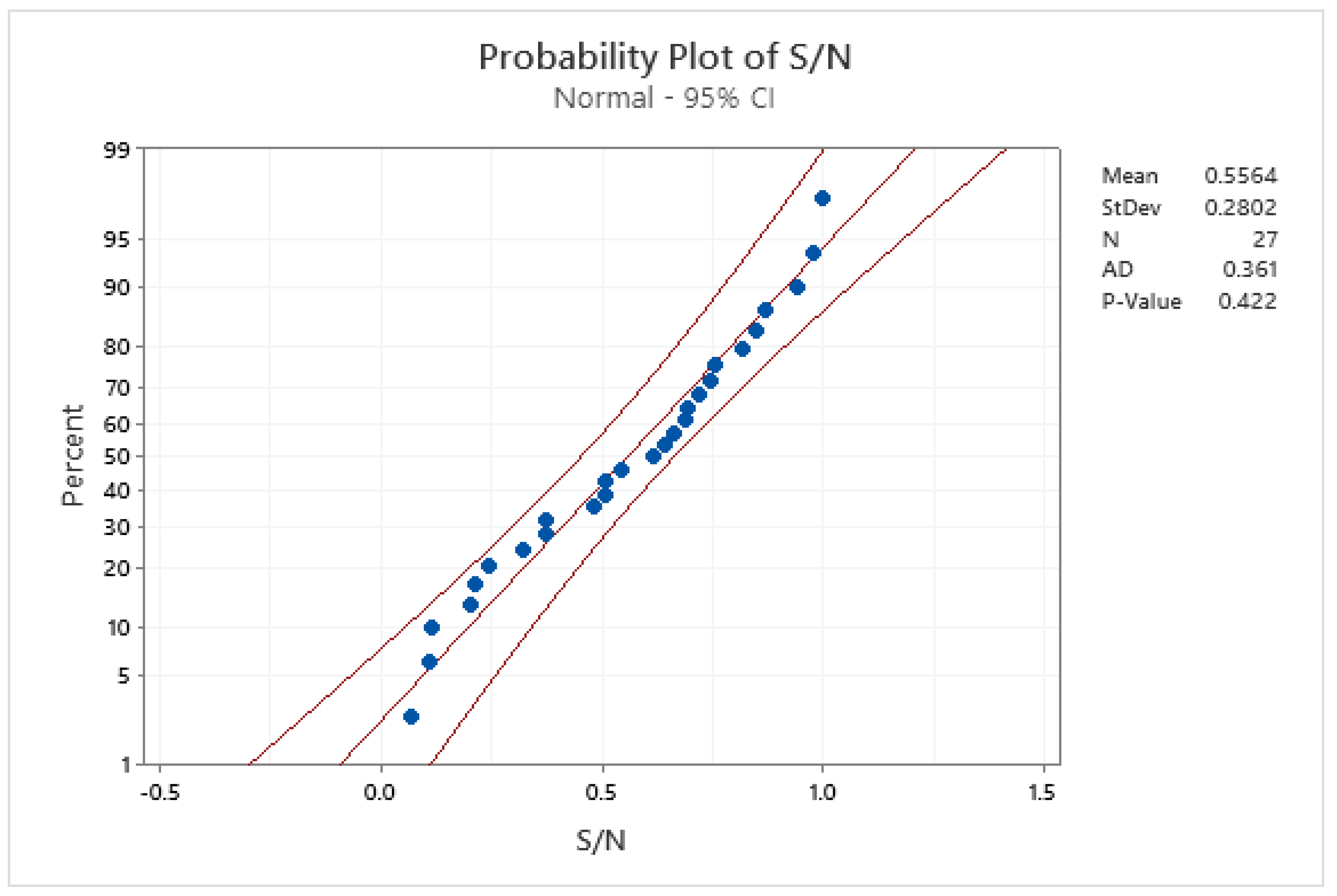


| Chemical Analysis of TiMMC | Aluminum (Al) | Vanadium (V) | Carbon (C) | Oxygen (O) | Iron (Fe) | Nitrogen (N) | Hydrogen (H) | Titanium (Ti) |
|---|---|---|---|---|---|---|---|---|
| Mass % | 5.55 | 3.84 | 0.97 | 0.26 | 0.004 | 0.21 | <0.003 | Remainder (89.163) |
| CoroMill 245 PVD TiAlN + TiN | Insert Specifications | |
|---|---|---|
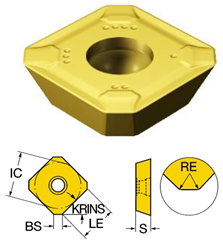 | Inscribed circle diameter (IC) | 13.4 mm |
| Cutting edge effective length (LE) | 10 mm | |
| Insert rake angle (GAN) | 15 deg | |
| Corner radius (RE) | 1.5 mm | |
| Coating (COATING) | PVD TiAlN + TiN | |
| Substrate (SUBSTRATE) | Coated carbide/Cermet (HC) | |
| Levels/Parameters | Initial Cutting Speed V1 (m/min) | Secondary Cutting Speed V2 (m/min) | Feed Rate f (mm/rev) |
|---|---|---|---|
| I | 40 | 40 | 0.1 |
| II | 60 | 60 | 0.15 |
| III | 80 | 80 | 0.2 |
| Experimental Run | Experimental Parameters | Responses | |||
|---|---|---|---|---|---|
| V1 (m/min) | V2 (m/min) | f (mm/rev) | VB max (µm) | ||
| 1 | 40 | 40 | 0.1 | 1.907 | 220.2 |
| 2 | 40 | 40 | 0.15 | 1.999 | 232.2 |
| 3 | 40 | 40 | 0.2 | 1.776 | 194.2 |
| 4 | 40 | 60 | 0.1 | 1.684 | 179 |
| 5 | 40 | 60 | 0.15 | 1.902 | 138 |
| 6 | 40 | 60 | 0.2 | 1.769 | 159 |
| 7 | 40 | 80 | 0.1 | 3.685 | 296.3 |
| 8 | 40 | 80 | 0.15 | 4.185 | 228.6 |
| 9 | 40 | 80 | 0.2 | 3.983 | 283.6 |
| 10 | 60 | 40 | 0.1 | 1.284 | 114.5 |
| 11 | 60 | 40 | 0.15 | 1.257 | 123.5 |
| 12 | 60 | 40 | 0.2 | 1.517 | 153 |
| 13 | 60 | 60 | 0.1 | 2.514 | 204.5 |
| 14 | 60 | 60 | 0.15 | 2.884 | 162 |
| 15 | 60 | 60 | 0.2 | 2.194 | 151.7 |
| 16 | 60 | 80 | 0.1 | 3.687 | 299.3 |
| 17 | 60 | 80 | 0.15 | 3.318 | 271.2 |
| 18 | 60 | 80 | 0.2 | 3.447 | 243.5 |
| 19 | 80 | 40 | 0.1 | 1.683 | 166.3 |
| 20 | 80 | 40 | 0.15 | 1.483 | 150.4 |
| 21 | 80 | 40 | 0.2 | 1.565 | 119.2 |
| 22 | 80 | 60 | 0.1 | 1.023 | 95.4 |
| 23 | 80 | 60 | 0.15 | 1.028 | 75.4 |
| 24 | 80 | 60 | 0.2 | 1.083 | 81.3 |
| 25 | 80 | 80 | 0.1 | 3.43 | 187.5 |
| 26 | 80 | 80 | 0.15 | 3.381 | 189.4 |
| 27 | 80 | 80 | 0.2 | 3.574 | 201.3 |
| Experimental Run | Normalized Value | Weighted Normalized Value | ||
|---|---|---|---|---|
| VB max (µm) | VB max | |||
| 1 | 143.9418 | 220.542 | 0.0719 | 0.1102 |
| 2 | 150.8861 | 232.561 | 0.0754 | 0.1162 |
| 3 | 134.0538 | 194.502 | 0.0670 | 0.0972 |
| 4 | 127.1096 | 179.278 | 0.0635 | 0.0896 |
| 5 | 143.5644 | 138.214 | 0.0717 | 0.0691 |
| 6 | 133.5255 | 159.247 | 0.0667 | 0.0796 |
| 7 | 278.1466 | 296.76 | 0.1390 | 0.1483 |
| 8 | 315.887 | 228.955 | 0.1579 | 0.1144 |
| 9 | 300.6399 | 284.04 | 0.1503 | 0.1420 |
| 10 | 96.9173 | 114.678 | 0.0484 | 0.0573 |
| 11 | 94.8793 | 123.692 | 0.0474 | 0.0618 |
| 2 | 114.5043 | 153.238 | 0.0572 | 0.0766 |
| 13 | 189.7587 | 204.818 | 0.0948 | 0.1024 |
| 14 | 217.6865 | 162.252 | 0.1088 | 0.0811 |
| 15 | 165.6048 | 151.936 | 0.0828 | 0.0759 |
| 16 | 278.2976 | 299.765 | 0.1391 | 0.1498 |
| 17 | 250.4452 | 271.621 | 0.1252 | 0.1358 |
| 18 | 260.1822 | 243.878 | 0.1300 | 0.1219 |
| 19 | 127.0341 | 166.558 | 0.0635 | 0.0832 |
| 20 | 111.938 | 150.634 | 0.0559 | 0.0753 |
| 21 | 118.1274 | 119.385 | 0.0590 | 0.0596 |
| 22 | 77.2168 | 75.517 | 0.0386 | 0.0377 |
| 23 | 77.5942 | 79.724 | 0.0387 | 0.0398 |
| 24 | 81.7457 | 81.426 | 0.0408 | 0.0407 |
| 25 | 258.899 | 187.791 | 0.1294 | 0.0938 |
| 26 | 255.2005 | 189.694 | 0.1276 | 0.0948 |
| 27 | 269.7683 | 201.613 | 0.1348 | 0.1008 |
| Experimental Run | Separation Measures | Closeness Coefficient | Signal-to-Noise Ratio | |
|---|---|---|---|---|
| S/N | ||||
| 1 | 0.0796 | 0.0947 | 0.5431 | −5.302 |
| 2 | 0.0865 | 0.0891 | 0.5072 | −5.8952 |
| 3 | 0.0658 | 0.1051 | 0.6149 | −4.22267 |
| 4 | 0.0574 | 0.1120 | 0.6610 | −3.5956 |
| 5 | 0.0455 | 0.1181 | 0.7216 | −2.83334 |
| 6 | 0.0503 | 0.1151 | 0.6957 | −3.15058 |
| 7 | 0.1492 | 0.0189 | 0.1126 | −18.9671 |
| 8 | 0.1417 | 0.0355 | 0.2005 | −13.9564 |
| 9 | 0.1526 | 0.0110 | 0.0677 | −23.3833 |
| 10 | 0.0218 | 0.1434 | 0.8677 | −1.23165 |
| 11 | 0.0255 | 0.1413 | 0.8467 | −1.44461 |
| 2 | 0.0430 | 0.1245 | 0.7433 | −2.57565 |
| 13 | 0.0856 | 0.0790 | 0.4800 | −6.37498 |
| 14 | 0.0824 | 0.0845 | 0.5062 | −5.91241 |
| 15 | 0.0583 | 0.1054 | 0.6438 | −3.82474 |
| 16 | 0.1504 | 0.0187 | 0.1110 | −19.0889 |
| 17 | 0.1306 | 0.0356 | 0.2145 | −13.3704 |
| 18 | 0.1242 | 0.0395 | 0.2416 | −12.3371 |
| 19 | 0.0517 | 0.1156 | 0.6906 | −3.21494 |
| 20 | 0.0412 | 0.1263 | 0.7537 | −2.45495 |
| 21 | 0.0299 | 0.1338 | 0.8172 | −1.75247 |
| 22 | 0.0099 | 0.1571 | 0.9404 | −0.53337 |
| 23 | 0.0001 | 0.1636 | 0.9988 | −0.01039 |
| 24 | 0.0036 | 0.1601 | 0.9775 | −0.19727 |
| 25 | 0.1067 | 0.0629 | 0.3709 | −8.6133 |
| 26 | 0.1056 | 0.0629 | 0.3733 | −8.55673 |
| 27 | 0.1150 | 0.0543 | 0.3209 | −9.87205 |
| Level | V1 | V2 | f |
|---|---|---|---|
| 1 | −9.034 | −3.122 | −7.436 |
| 2 | −7.351 | −2.937 | −6.048 |
| 3 | −3.912 | −14.238 | −6.813 |
| Delta | 5.122 | 11.301 | 1.387 |
| Rank | 2 | 1 | 3 |
Publisher’s Note: MDPI stays neutral with regard to jurisdictional claims in published maps and institutional affiliations. |
© 2022 by the authors. Licensee MDPI, Basel, Switzerland. This article is an open access article distributed under the terms and conditions of the Creative Commons Attribution (CC BY) license (https://creativecommons.org/licenses/by/4.0/).
Share and Cite
Kamalizadeh, S.; Niknam, S.A.; Balazinski, M.; Turenne, S. The Use of TOPSIS Method for Multi-Objective Optimization in Milling Ti-MMC. Metals 2022, 12, 1796. https://doi.org/10.3390/met12111796
Kamalizadeh S, Niknam SA, Balazinski M, Turenne S. The Use of TOPSIS Method for Multi-Objective Optimization in Milling Ti-MMC. Metals. 2022; 12(11):1796. https://doi.org/10.3390/met12111796
Chicago/Turabian StyleKamalizadeh, Saeid, Seyed Ali Niknam, Marek Balazinski, and Sylvain Turenne. 2022. "The Use of TOPSIS Method for Multi-Objective Optimization in Milling Ti-MMC" Metals 12, no. 11: 1796. https://doi.org/10.3390/met12111796
APA StyleKamalizadeh, S., Niknam, S. A., Balazinski, M., & Turenne, S. (2022). The Use of TOPSIS Method for Multi-Objective Optimization in Milling Ti-MMC. Metals, 12(11), 1796. https://doi.org/10.3390/met12111796






